How Many Armored Vehicles Has Israel Lost Fighting Hamas?
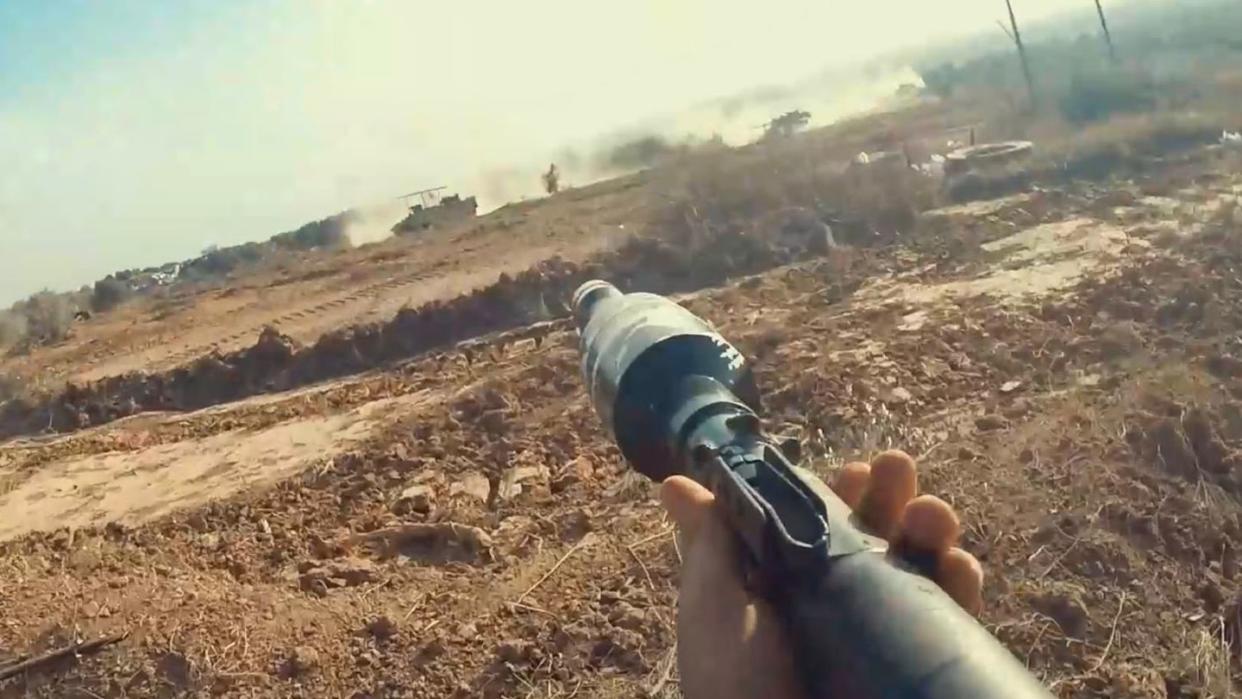
A video published by Hamas militants on social media shows a close assault on an Israeli tank recorded by a helmet-mounted camera. The outcome of the incident is unclear.
In the video, the fighter from Hamas’s Al-Qassam military wing emerges from Hamas’s extensive underground tunnel network (stretching hundreds of miles and stocked with arms and supplies) to take up a concealed firing position near Al Zaytoun, by which a column of Israeli Merkava tanks is rolling.
Once the tanks have passed, the fighter sprints up to a tank and manually places a shaped-charge armor-piercing grenade on its side hull. The hanging steel balls and chains used to protect the vulnerable area between the rear turret and hull from rocket propelled grenades (RPGs) is clearly visible.
The fighter scurries back to his firing position, and a blast can be heard behind him. He then turns around and discharges a Hamas-built 105-millimeter Yassin RPG at the Israeli tanks. The flash as the RPG’s shaped-charge warhead detonates is briefly visible.
Crazy video showing Hamas fighter emerging from a tunnel and placing IED on IDF Merkava tank. pic.twitter.com/u1PnAUqosP
— Aldin 🇧🇦 (@aldin_aba) November 2, 2023
The attack’s effect is unknown. The hand-placed warhead appears to have been placed at angle that would cause its directional shaped-charge warhead to shoot an explosive jet of molten metal parallel to the tank’s hull rather than inward, meaning the blast would mostly vent into the open air. Some argue that the round was placed to disable the tank’s side-turret mounted Trophy protection system, but if so, the charge’s tip would have likely been pointed upward. As for the RPG shot, we don’t see enough to tell whether it penetrated the armor or not.
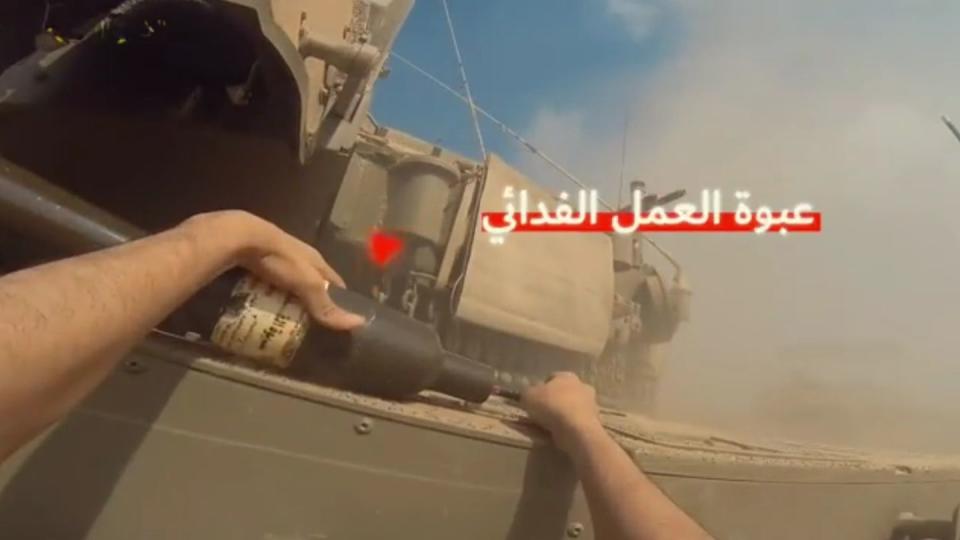
This is a common limitation of combat footage released by Hamas—it shows attacks that hit Israeli tanks and armored personnel carriers (APCs), but no imagery afterward confirming the extent of the damage.
Hamas released footage of ground fighting against Israeli mechanized forces. I suspect there are active protection systems at work in some of the scenes. pic.twitter.com/Wy3CMIgtgA
— Joe Truzman (@JoeTruzman) November 4, 2023
#Palestine / #Israel 🇵🇸🇮🇱: Al-Qassam Brigades (#HAMAS) carried out attacks on #IDF Troops, armored vehicles and Merkava tanks in #Gaza.
The fighters used RPG-7 Launchers, 105mm "Al-Yassin" and "Al-Yassin TBG" Tandem anti-tank rockets and #China-made 🇨🇳 Type 56-1 rifles. pic.twitter.com/SBlqbdOmzP— War Noir (@war_noir) November 8, 2023
After all, a hit defeated by armor still produces a flashy blast with debris, smoke, and sometimes even small external fires. But if a tank is fully knocked out, one may observe crew bailing out, warping or fragmentation of surfaces, the tank erupting into sustained flames, or smoke continuously pouring out from internal fires or explosions. (Non-penetrating hits may sometimes disable a vehicle’s sensors, weapons, or tracks, potentially leaving it unable to perform its mission until repaired.)
Furthermore, the explosive reactive armor and Trophy active protection system defending Israeli tanks produce explosive flashes of their own when intercepting incoming attacks. See, for example, the Trophy interception captured on video below at the 30-second mark. Note that the point-of-view tank also sports a ‘cope cage’ to protect against drone-dropped grenades.
The work of the Trophy APS at 02 and 30 second. pic.twitter.com/zL1YejHI77
— 𝔗𝔥𝔢 𝔇𝔢𝔞𝔡 𝔇𝔦𝔰𝔱𝔯𝔦𝔠𝔱 🇬🇪🇺🇦🇺🇲🇬🇷 (@TheDeadDistrict) November 4, 2023
It’s understandable that anti-tank ambushers withdraw after firing to avoid return fire, but without visuals on the vehicle’s status after the blast, not much can be inferred. For this reason, drone footage released by Russia and Ukraine’s military often does linger to show the post-strike status of vehicles.
The Israeli Defense Forces (IDF) has reported 33 soldiers killed in action as of November 8. This includes the commander of Israel’s 53rd Tank Battalion (188th Brigade), and an Israeli Druze Arab named Lt. Col. Salman Habaka. The blogArmada Rotta, seeking to count vehicles losses in October based on visual evidence, estimated it had proof of the destruction of at least four Merkava tanks.
This article looks at the armored vehicles, anti-armor weapons, and tactics used by the IDF, Hamas, and its allies in the ground conflict in Gaza.
Israel’s heavily armored tanks and APCs
The IDF has historically favored its armored corps to lead major ground operations, and the conflict in Gaza is no exception. In late October, after initial hit-and-run raids, IDF armor units advanced into northern Gaza from multiple directions, encircled Gaza City, and cut off maritime lines of communication.
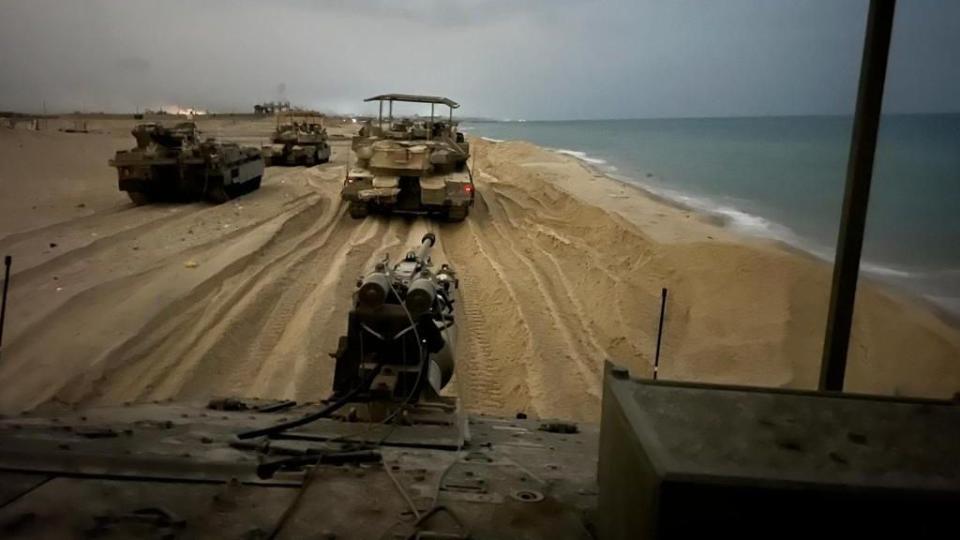
IDF tanks and APCs are much better protected than the Soviet/Russian armor used in Ukraine, and thus pose significant challenges to Hamas. Israel’s indigenous Merkava (“Chariot”) tank, with its distinctive wedge-shaped turret, is known for its multi-layered protection that incorporates thick composite plates and bricks of explosive reactive armor. It also incorporates the Trophy system, which uses radar and optical sensors to detect incoming missiles and rockets, warn the crew of the attack point of origin, and automatically shoot threats down with a counter-shot.
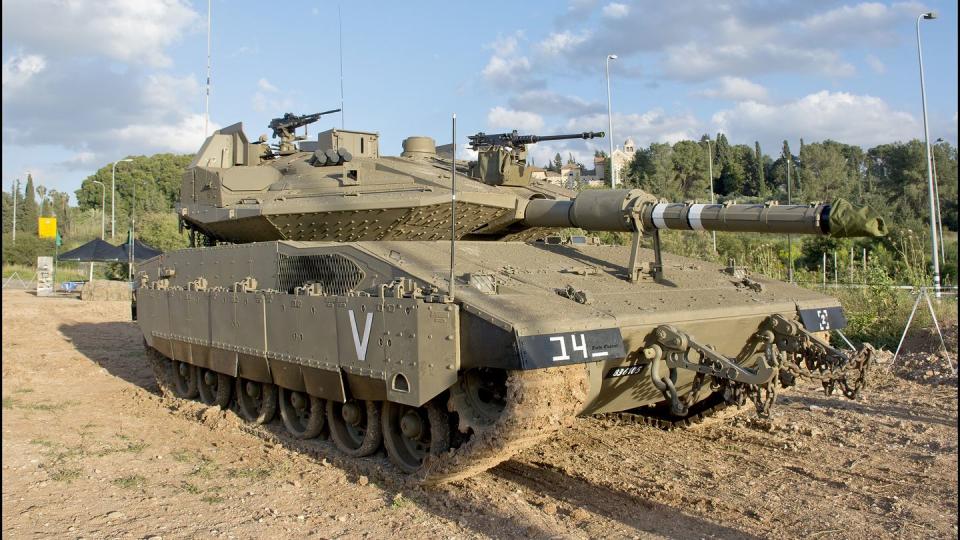
Until the 2023 Gaza conflict, no attacks are known to have successfully penetrated Trophy-equipped vehicles. Some sources claim that the Merkavas that were knocked out on October 7 may not have had active Trophy systems. Hamas anti-tank rocket teams attempt to attack Trophy-equipped tanks from within 50 meters-range, which they believe is the minimum-defeat distance of the system.
The IDF’s pre-conflict active-duty units operate the Trophy-equipped Merkava 4M ‘Windbreaker,’ and (just this fall) received their first production of Merkava 4 Barak (“Lightning”) with improved sensors and armor. Older, non-Trophy-equipped Merkava 4s and 3s remain in reserve units—including Merkava 3s intended for sale to Cypress and Morocco, which have now been redirected to the newly formed Of Hol (“Phoenix”) volunteer reserve tank battalion. Merkava IIBs, relegated to training duties in 2020, have also been seen in combat during Hamas’s initial October 7 attack.
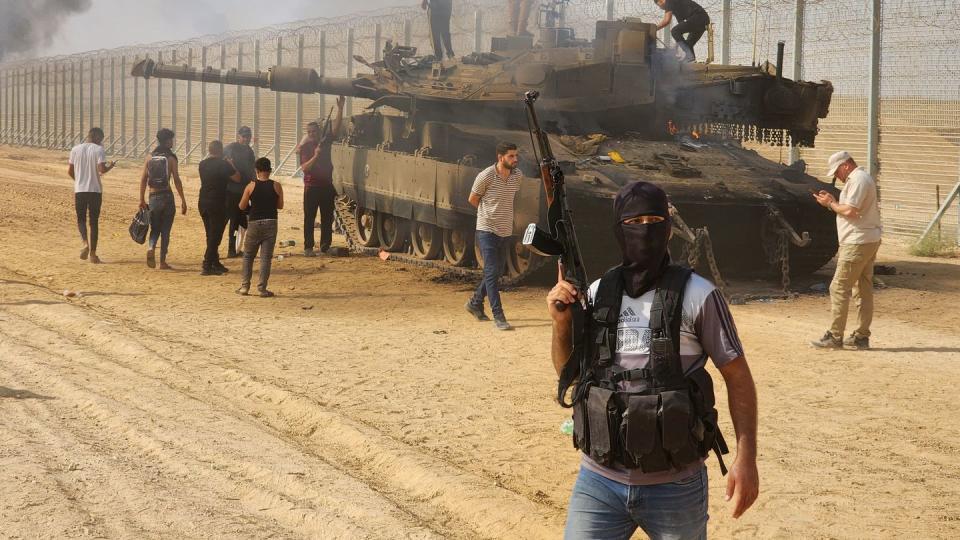
When battling Hamas anti-tank teams, the Merkava’s 120-millimeter main gun can fire M339 Hatsav fragmentation shells—designed to explode after penetrating building walls—and Kalanit (“Anenome”) rounds—programmed to airburst over trenches or behind buildings and hills. It can also release six sub-munitions to blast targets outside the tank’s direct line of sight. Additionally, Merkavas can employ a 60-millimeter mortar for indirect fire.
Unlike most armies, the IDF also fields ‘heavy APCs’ with armor equal in toughness to what’s on a main battle tank. That makes these APCs dramatically more robust than the Vietnam-era M113 APCs that the IDF now assigns to lower-risk roles. The most important is the 70-ton Namer (“Leopard”) based on the hull of the Merkava IV tank. The IDF maintains roughly Namers, which each have a crew of three and capacity for nine mounted infantry. A subset of Namers are also equipped with Trophy.
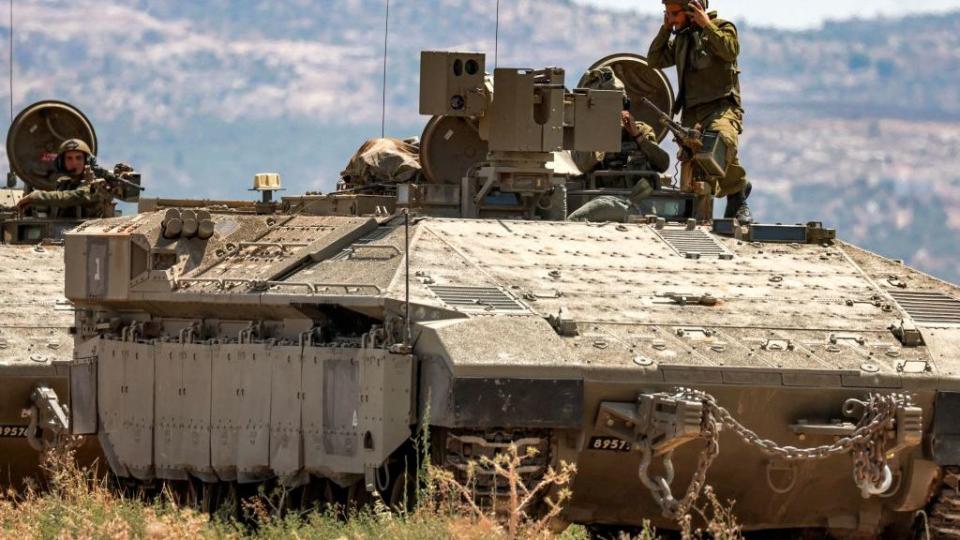
The IDF also retains roughly 100 49-ton Achzarit (“Brutal”) heavy APCs based on captured Soviet T-54/55 tanks, with reinforced armor and the turrets removed. The current Achzarit Mark II incorporates an uprated American diesel engine and remote-control machine gun.
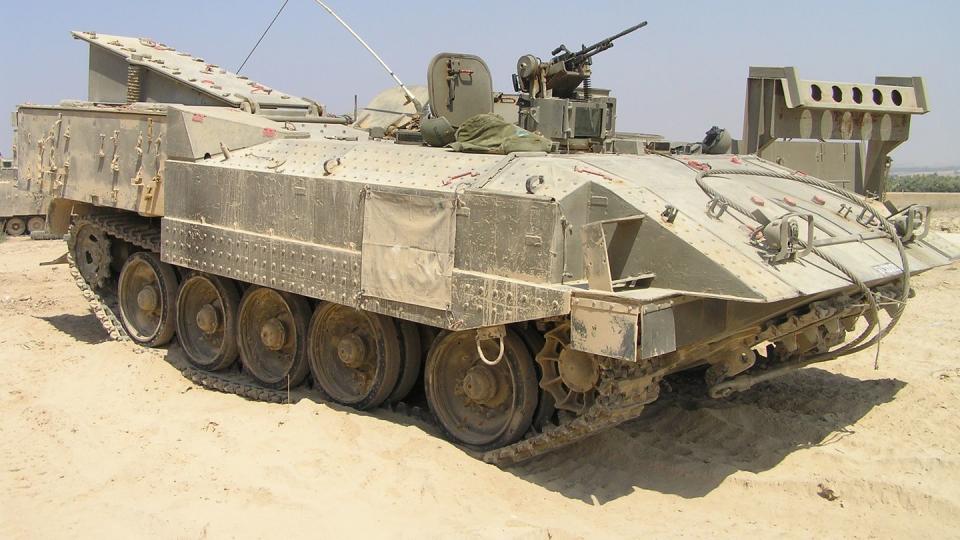
The IDF also just began fielding a new, 35-ton Eitan eight-wheeled infantry fighting vehicle based on a chassis by U.S.-company Oshkosh. Presently armed only with remote-controlled machine guns, these may eventually carry unmanned 30- or 40-millimeter autocannon turrets with Spike missiles. Instead of Trophy, Eitan relies on the Iron Fist Light active-protection system, and also features non-explosive reactive armor and a mine-resistant V-shaped hull with high ground clearance.
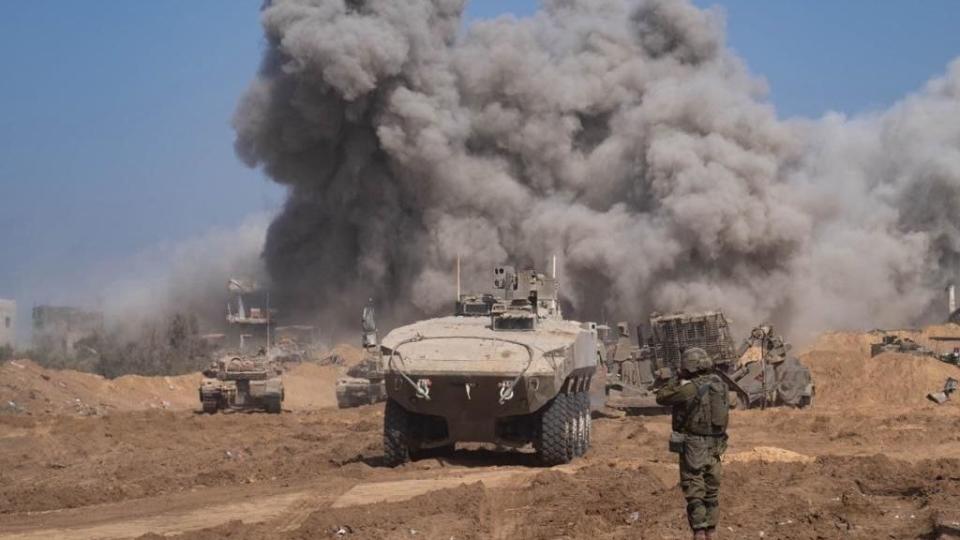
Eitans operated by the 933rd Nahal Infantry Brigade first saw combat on October 7, reportedly rolling down Highway 6 at 75 miles per hour to relieve besieged civilian defense forces at the kibbutz of Zikim before the area could be overrun. A photo released by the IDF shows that Eitans have entered Gaza.
Also playing a prominent combat role in urban areas are armored engineering vehicles—particularly the Caterpillar D9 Doobi (“Teddy Bear”) armored tractor and the Puma engineering vehicle, which is based on the Centurion Sh’ot tank and armed with the Carpet mine-clearing system consisting of 20 thermobaric rockets.
An IDF Puma IEV/APC is seen firing a "Carpet" thermobaric mine clearing mortar round in somewhere central Gaza.#HamasAttack #Israel #Hamas #Hezbollah #Palestine #OSINT pic.twitter.com/aNbwYALrfz
— OSINT (Uri) 🇺🇦 (@UKikaski) November 2, 2023
Armor 'captured' by Hamas
Hamas’s assault on October 7 saw its fighters overrun several Israeli military bases with armored vehicles parked inside. There is so far no evidence Hamas was able to move or operate the heavy armor, and it’s unclear how many of these vehicles were damaged or destroyed before the IDF recaptured these bases.
At the time of writing, the Armada Rotta blog’s count of these briefly ‘captured’ tanks and APCs includes 7 Merkava IVMs, three Merkava IIBs, 24 Namer, 10 Achzarit APCs, four M106 Keshet 120-millimeter mortar carriers (based on the M113), and eight M113s.
The Palestinians enter the Israeli military base in Nakhal Oz in southern Israel, where the IDF left a number of Humvees and over a dozen of Achzarit heavy armored personnel carriers. pic.twitter.com/cGBuRjibnC
— Status-6 (Military & Conflict News) (@Archer83Able) October 7, 2023
Hamas’s anti-tank guided missiles
Hamas’s most capable anti-armor weapons are anti-tank guided missiles (ATGMs)—typically bulky, laser-guided Soviet/Russian weapons capable of hitting tanks from up to 3 miles away.
These relatively rare and valuable assets have been singled out for targeting by Israeli strikes. Hama’s most lethal anti-armor attack, in fact, appears to have involved an ATGM that hit a Namer APC, killing 11 and wounding four. That day, two more IDF soldiers were killed by ATGMs. That’s roughly one-third of confirmed Israeli military deaths in the first month of combat since October 7.
Hamas’s most important ATGM is the Russian-origin 9M133 Kornet-E (and Dehlavieh, an Iranian knockoff), with its large 152-millimeter missile and tandem charges designed to defeat explosive reactive armor. These were effective against Merkavas in the 2006 Lebanon conflict, but in a 2014 conflict with Hamas, IDF Trophy systems successfully defeated Hamas Kornet attacks.
Wow, at least 14 9M133-1 AT and 7 9M133-1 TB (Thermobaric) Dehlavieh ATGM seized by the USS Forest Sherman on the way to Yemen, along with other hardware. Iranian produced version of the potent Kornet ATGM- seen in use in the big houthi ambush a few months back.
via @LMartinezABC pic.twitter.com/u62uRmDhLI— Cᴀʟɪʙʀᴇ Oʙsᴄᴜʀᴀ (@CalibreObscura) December 5, 2019
Hezbollah has advertised that it has developed a twin-launcher mount called Tharallah on the theory that a second missile, fired.4 seconds after the first, will hit the target before the Trophy launcher can reload (which takes 1.5 seconds).
Hezbollah media is hyping the Tharallah anti-tank guided missile system. It launches two Dehlavieh missiles, Iranian-made variants of the Russian Kornet, 0.4 seconds apart. It was designed specifically to defeat the protection system on Israel's Merkava main battle tanks. pic.twitter.com/JLI5C8fu5q
— Mike (@Doranimated) November 6, 2023
Hezbollah reportedly used Thara Allah to destroy an M113 APC on the Lebanese border. This vehicle, however, doesn’t have Trophy, and wouldn’t have required particularly powerful ordinance to destroy.
Hamas has also advertised its possession of North Korean Bulsea-2 missiles—a reverse-engineered variant of the older Soviet 9K111 missile with laser-guidance. They haven’t yet been seen in use, however.
#Palestine / #Israel 🇵🇸🇮🇱: Al-Qassam Brigades (#HAMAS) released a new photo with the message “So watch them and be patients...” from #Gaza.
The photo shows a fighter with a rare Bulsae-2 laser-guided HEAT missile —originally produced by #NorthKorea (#DPRK) 🇰🇵 and based on 9K111. pic.twitter.com/ZIV6EMXXFR— War Noir (@war_noir) November 4, 2023
Hamas tactical drones
Hamas’s October 7 assault on Israel’s Gaza border wall involved the use of civilian DJI and Autel quadcopter drones (and even the larger DJI Matric-600 hexacopter), which dropped shaped-charge grenades on Israeli border sentry guns and sensors. This tactic was informed by observations of civilian-type drone adaptation in the war in Ukraine.
Hamas also used this method to damage or destroy a moving Merkava tank. The Trophy system may have a donut-hole like window of vulnerability to attacks from directly above, or the slow speed of the drone and the gravity-dropped grenade might have caused it to be filtered out by the Trophy’s sensors.
🔴 BREAKING NEWS | 🇵🇸 🇮🇱 🎥‼
Image of Israeli tank being attacked by drones.#Israel | #Hamas | #Gaza | #TelAviv#Tsahal | #Palestine | #Merkava #Drone | #BreakingNews #Usa pic.twitter.com/bjPjC5yqyK— Breaking News (@PlanetReportHQ) November 8, 2023
Trophy builder Rafael has announced that it is upgrading the system to deal with drone threats in the new Merkava Barak model, suggesting the original model’s anti-drone performance could use enhancement.
Another recording, however, shows that an accurate drone-dropped grenade attack didn’t succeed, despite producing a debris-laden explosion.
A Hamas drone dropped an explosive on an IDF Merkava tank on Thursday, according to the group. pic.twitter.com/0xYsL8QeSC
— Joe Truzman (@JoeTruzman) October 20, 2023
That’s because the grenade drifted into the tank’s rear-turret storage basket (or ‘bustle’). The debris came from tarp and other things in the bustle being shredded, but not from penetration of the armor.
In response to these early attacks, Israeli tanks have been seen mounting turret-top ‘cope cages’ designed to defeat drone-dropped grenade attack—a field-improvised modification first observed on Russian tanks shortly before the large-scale invasion of Ukraine.
#Israel/#Hamas 🇮🇱🇵🇸:
Merkava Mk.3 tanks of the 🇮🇱Israeli Defence Forces with with improvised cope cages against drone-dropped grenades, inside the eastern outskirts of Bait Hanoun. pic.twitter.com/HUNLDe9Moo— 𝕻𝖗𝖆𝖎𝖘𝖊 𝕿𝖍𝖊 𝕾𝖙𝖊𝖕𝖍 (@praisethesteph) October 31, 2023
Hamas has also used drones to spot and attack bivouacked Israeli tank crews while clustered outside of their tanks in sunken pits, striking with drone-dropped grenades or anti-tank teams dispatched to mount an ambush.
Here is footage of a grenade being dropped from a drone into a crowd of Israeli soldiers by Hamas.
This is the second time I am seeing such a large group of Israeli soldiers huddled in a hole & surrounded on all sides by Merkava tanks. This is stupid, imo. Especially after… pic.twitter.com/5FWCWyFeIh— Char (@cqc_coffee_guns) November 1, 2023
There has not been a large quantity of drone footage released by Hamas since October 7. That suggests it has a relatively small drone inventory that it will use more selectively than the tens of thousands used and lost in the war in Ukraine.
Hamas’s homemade rocket-propelled grenades and mines
While ATGMs are more capable, the most numerous of Hamas’s anti-tank weapons are portable rocket-propelled anti-tank grenades (RPGs)—typically accurate out to 200 to 300 meters. Hamas has produced its own Al-Yassin RPGs in underground workshops since 2004, what are patterned off the ubiquitous Soviet RPG-7V, with its conical 85-millimeter shaped-charge warhead.
Fascinating footage from al Qassam of the manufacture, deployment, and operational use of their previously unknown copy of the potent PG-7VR tandem HEAT projectile, known as the "RPG-7VR" or "al Yassin"- named like their old PG-2 copy, but far more capable. #Gaza pic.twitter.com/FfzaE8aJS7
— Cᴀʟɪʙʀᴇ Oʙsᴄᴜʀᴀ (@CalibreObscura) October 14, 2023
Such RPGs are ineffective against Israeli heavy armor, however, leading to the recent adoption of a larger, 105-millimeter version of the Yassin with a tandem charge-warhead to help defeat explosive reactive armor.
Though RPGs are relatively cheap, a tank must unwittingly approach relatively close to infantry lying in ambush to present a viable target. Then, after springing the ambush, such a short-range anti-tank team needs a covered path to escape retaliatory fire.
Even the Yassin-105 likely needs to strike the thinner side or rear armor of Merkavas or Namers to have a chance of penetrating, as seen in the attack recorded in Gaza City’s Sheikh Radwan district (below). Yet again, the attack’s outcome is unclear.
🚨🔥 مشااااااااهد لسرايا القدس 🔥🚨 سرايا القدس تستهدف بقذيفة تاندوم مضادة للدروع آلية "ميركفا 4 باز" للعدو شمال غرب الشيخ رضوان. pic.twitter.com/Ton3J0LgCe
— نشّاب | Nashab 🇯🇴 (@Nashab_32) November 8, 2023
Hamas’s use of its tunnel system for prepared anti-tank ambushes is, therefore, an effective way to conduct such rear-aspect ambushes in a relatively survivable manner.
At least a 5 man Hamas RPG team (there may be a 6th guy at a second position indicated) using tunnels to hit 2 Merkava 3 Baz tanks in the side with “Al Yassin” rockets, From the closeup it looks like at least one of the rockets falls short and there isn’t any visible damage pic.twitter.com/5RZaNb57FR
— TankDiary (@TankDiary) November 3, 2023
Mines and remotely-detonated improvised explosive devices (IEDs) are also effective against the vulnerable tracks and belly armor of even heavily armored vehicles. At least one Hamas IED reportedly killed two IDF soldiers in a Merkava tank and wounded the other two crewmembers.
Why weren’t the Israeli tanks screened by infantry?
Tanks have notoriously poor visibility of especially close threats, making areas with dense terrain and opportunities for concealment (cities, forests etc.) extremely dangerous for armored units. It’s therefore considered best practice to escort armored vehicles with screening infantry—or ‘bubble wrap’—which can detect and engage anti-tank teams before they have an angle to attack vulnerable top, side, or rear armor.

Observers have noted the absence of screening IDF infantry in ambush videos posted by Hamas. But there are a few factors to bear in mind.
First, it’s possible we’re only seeing videos of those times Israeli armor was vulnerable to ambush. When a mechanized force is advancing to contact with an enemy whose exact position is unknown, infantry may remain embarked to allow a faster rate of advance—at least, until a close threat is detected.
The IDF may be betting that it will suffer lower overall casualties by keeping infantry inside their APCs and counting on the heavy armor, active protection systems, and sensors to see the vehicles through—even if that means getting surprised by more ambushes. There may be many IDF vehicle losses going unreported, as their crews escape unscathed or only wounded.
Hamas and its allies are hitting IDF tanks, and sometimes disabling them. But despite adept tactics and technical innovations displayed by its fighters, evidence hasn’t yet surfaced of numerous destroyed or abandoned IDF armored vehicles in one place, as was seen in the first battle of Grozny, or Russia’s 2022 attack on Kyiv.
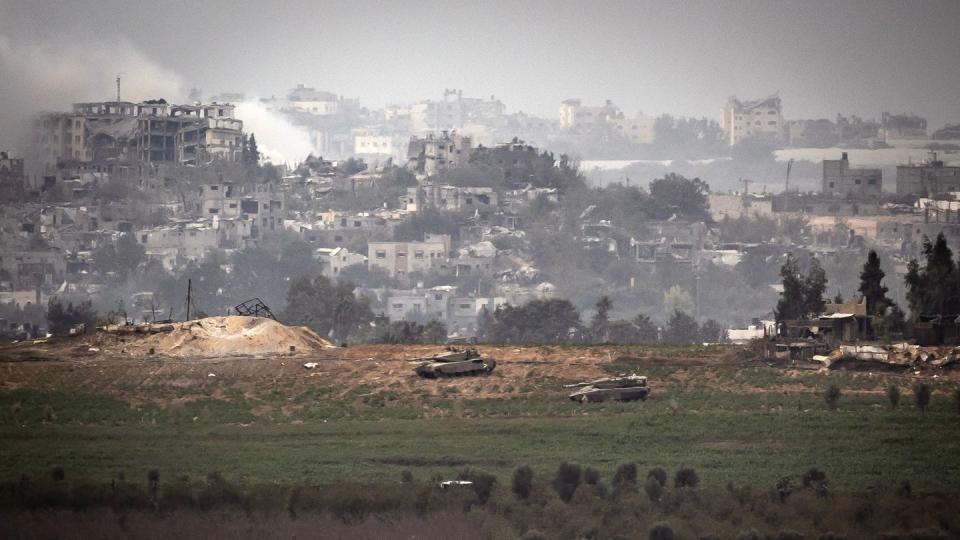
You Might Also Like

